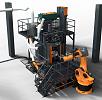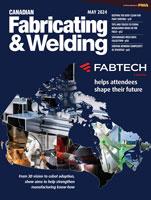Associate Editor
- FMA
- The Fabricator
- FABTECH
- Canadian Metalworking
Aluminum filler: Options and how they affect quality
Filler selection will affect quality and strength of the finished product, so choose wisely.
- By Lindsay Luminoso
- Updated January 18, 2023
- January 14, 2015
- Article
- Welding

Once consideration is given to the base material and treatment of the material post-welding, selecting the correct aluminum filler metal for the job can be a less daunting task.
While aluminum is a material of growing importance in the welding, fabrication and metalworking industries, it can prove to be challenging to use. Rules that generally apply to mild steel do not necessarily apply to welding aluminum. So how does one select the correct filler alloy for the job?
CONSIDER POTENTIAL ISSUES WITH THE FINISHED WORK
The first consideration when selecting a welding filler alloy is to determine what factors may become an issue in the finished work. For example, is the base material susceptible to cracking? Since the weld chemistry is determined by the base material, the filler alloy and the weld dilution, filler-alloy chemistry plays a crucial role in determining cracking sensitivity.
Another consideration is final weld strength. Unlike steel, aluminum welds rarely are as strong as the base material. Since different filler alloys have differing tensile and shear strengths, selecting the correct filler alloy is critical.
Often, weld appearance and aesthetics play a role. For example, 4xxx alloys often are easier to work with, providing excellent fluidity that delivers improved weld appearance over 5xxx alloys. They also provide good crack resistance and are less prone to develop porosity. However, if the finished product will be anodized, 5xxx alloys should be used. Anodizing often is used when the finished product will be painted, and 5xxx alloys provide the best colour match.
Will the part be cold-worked or formed after welding? Ductility is not an important characteristic for most welding applications unless the part will undergo roll bending or another forming process after welding.
These considerations and others must be made before finalizing an aluminum filler alloy for a welding application. Once the desired factors are selected, selecting from and within an alloy family becomes an easier task.
What filler metal is used for aluminum? Advantages of different filler families
Filler alloys are available in the 1xxx, 2xxx, 4xxx and 5000 families, but for the purpose of this article, we’ll evaluate the features and benefits of the two most common alloy families, 4xxx and 5xxx.
The 4xxx alloys use silicon (Al-Si) as the primary alloying element, the most common of which are 4043 and 4047. As mentioned earlier, The Al-Si filler alloys are characterized by excellent fluidity and very good resistance to weld cracking. In addition, they are less prone than the 5xxx fillers to develop porosity in the weld.
When welding 6xxx extrusions or plate, such as 6061, the 4xxx filler alloys are widely used because the resulting weld chemistry helps reduce crack sensitivity common in this base-material family. Generally, 4xxx filler alloys should not be used to weld aluminum-magnesium (Al-Mg) 5xxx base materials. The combination of silicon and magnesium can produce an intermetallic compound known as magnesium silicide, which is very brittle. The result is welds that tend to have poor ductility and toughness. Note that there are exceptions to this rule when welding base alloys with relatively low magnesium levels, such as 5052.
If welding with 4xxx filler alloys, keep in mind that it is relatively soft and for diameters smaller than 1/16 inches (1.6 mm), a push-pull system such as Lincoln Electric’s Power Wave C300 with the Magnum Pro Aluminum gun is an optimal solution.
The 5xxx fillers, of which 5356 is the most common, often are simple Al-Mg binary alloys. The 5xxx alloys typically are selected for their strength. Manganese and higher levels of magnesium are typically added to further increase strength, as is the case with 5183 and 5556 filler alloys.
It should be noted that the 5xxx alloys require higher wire-feed speeds than 4xxx alloys to achieve the same heat output. Also, these alloys are not as fluid as 4xxx alloys, so the weld appearance may not be as uniform and smooth, although specialty 5xxx alloys, such as Lincoln Electric’s SuperGlaze 5356 TM, have been developed to improve “wetting.” Due to the magnesium levels in 5xxx alloys, black soot often is encountered, especially during MIG welding.
So why select 5xxx filler alloys? Simply because the mechanical properties are much better than those of 4xxx fillers. For example, ductility and shear strength are both significantly greater with 5356 over 4043. So if strength is of paramount concern, 5xxx alloys are the best choice.
WHEN IN DOUBT, ASK
Overall, once consideration is given to the base material and treatment of the material post welding, selecting the correct aluminum filler metal for the job can be a less daunting task. If faced with a particular challenge, experienced aluminum welding suppliers can help answer the questions leading you to the best filler alloy for the job at hand.
Gregory D. Doria is director of global sales and technical services for Lincoln Electric Aluminum Solutions, Mississauga, Ontario. www.lincolnelectric.com/alum
About the Author

Lindsay Luminoso
1154 Warden Avenue
Toronto, M1R 0A1 Canada
Lindsay Luminoso, associate editor, contributes to both Canadian Metalworking and Canadian Fabricating & Welding. She worked as an associate editor/web editor, at Canadian Metalworking from 2014-2016 and was most recently an associate editor at Design Engineering.
Luminoso has a bachelor of arts from Carleton University, a bachelor of education from Ottawa University, and a graduate certificate in book, magazine, and digital publishing from Centennial College.
subscribe now


Keep up to date with the latest news, events, and technology for all things metal from our pair of monthly magazines written specifically for Canadian manufacturers!
Start Your Free Subscription- Trending Articles
FMA Annual Meeting: Ingenuity still key with tech innovations

Messer Canada hosts anniversary event

Welding jacket designed for protection, comfort

Gang punching press system accommodates different parts quickly

Compact swing chamber shot blast machine features robotic workpiece handling

- Industry Events
MME Saskatoon
- May 28, 2024
- Saskatoon, SK Canada
CME's Health & Safety Symposium for Manufacturers
- May 29, 2024
- Mississauga, ON Canada
DiPaolo Machine Tools Open House 2024
- June 4 - 5, 2024
- Mississauga, ON Canada
FABTECH Canada
- June 11 - 13, 2024
- Toronto, ON Canada
Zoller Open House & Technology Days 2024
- June 12 - 13, 2024
- Ann Arbor, MI
















